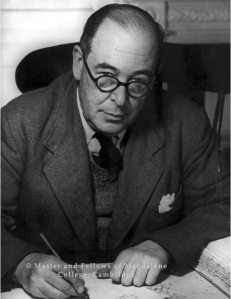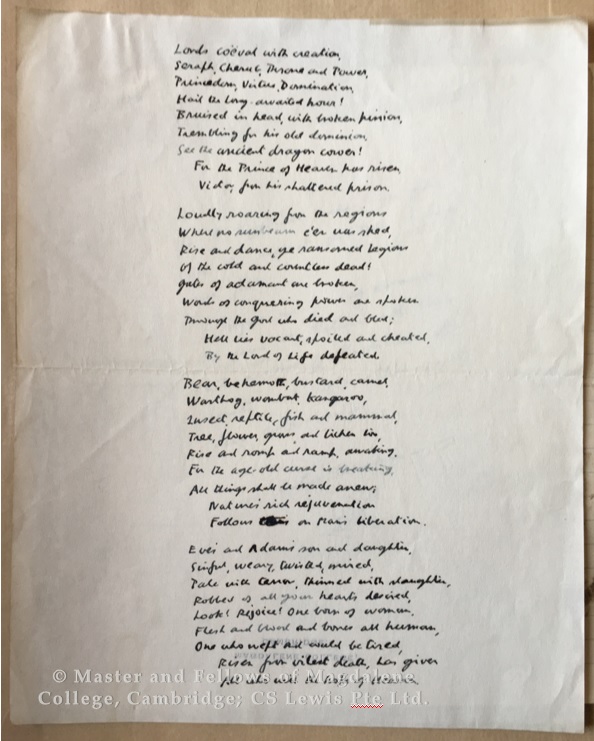In our new occasional series, Literary Magdalene, Professor Helen Cooper (Life Fellow of Magdalene) writes this guest post on C S Lewis. Until her recent retirement, Professor Cooper herself held the Chair of Medieval and Renaissance English in Cambridge, to which she refers in her opening paragraph.

C.S. Lewis
Although C.S. Lewis held the Chair of Medieval and Renaissance English in Magdalene for the last nine years of his life, and had a particular fondness for the college, he never fully uprooted himself from Oxford. The Chair had been created with him in mind, in the hope that his presence would counterbalance the English Faculty’s bias towards modernism while keeping its critical emphasis, an emphasis in much-vaunted contrast to Oxford’s more philological weighting. Lewis’s well-documented reluctance to leave his Oxford home, The Kilns at Headington, looked for a while as if it was going to prevent his accepting the post; but once it was agreed that he could live in Magdalene while commuting every week or so along the direct rail line between the cities (a line long since abolished), he was happy to take up the Chair. He called the College the ‘penitent Magdalene’, in complimentary contrast to Oxford’s ‘impenitent Madgalen’ that he had left behind.
Much as it suited Lewis, the arrangement meant that Magdalene has only a limited number of his books and papers. We have an almost complete set of his individual plays in the original series edition of his Arden Shakespeare – there are a few that he seems never to have acquired, including the three parts of Henry VI, Titus Andronicus and Timon of Athens; and a number of them contain annotations calling attention to unusual words, or summarizing variants between the earliest known prints. There is a file of his letters, with carbon copies of the College’s replies, relating to his on-off acceptance of the Chair: there is an article about them in the 1987-8 Magdalene College Magazine and Record, and the full set is now available in volume 3 of his Collected Letters (edited by Walter Hooper, 2006). There are a few off prints of articles about him, and a booklet recommending a walking tour of Lewis’s Cambridge. There are orders of service for the commemorations of the centenaries of his birth and death, and there are obituaries and typed memoirs. In addition, the College holds the letter in which he urged, successfully, that Pepys’s diaries should be published uncensored (see M E J Hughes, The Pepys Library, Scala, 2015).
There are two items of Lewis’s original literary writing in the collection. The most substantial is a Resurrection hymn that he wrote in June 1958 in response to a ‘challenge’ from Francis Turner, then the Pepys Librarian; we hold the original autograph in the Turner file in the College Archives. The accompanying note, on college notepaper, does not specify just what the challenge was; but perhaps it was to honour the antipodean animals that had been omitted from earlier accounts of the Creation. It remained unpublished until Hooper included it in the Collected Letters (vol. 3, pp. 955-6): a categorization justified on the grounds of the associated note, but which has meant that it has been largely overlooked. It was omitted from the Collected Poems until Don W. King’s edition of 2015 (Collected Poems of C.S. Lewis, pp. 393-4). The nine-line stanza does not fit any existing hymn tune, but it was given its first performance to music composed by Magdalene graduate Peter Relph at Evensong in the College Chapel on 9 June 2016.

Easter Hymn, Magdalene College Archives F/CSL/11
Lords coëval with creation,
Seraph, Cherub, Throne and Power,
Princedom, Virtue, Domination,
Hail the long-awaited hour!
Bruised in head, with broken pinion,
Trembling for his old dominion,
See the ancient dragon cower!
For the Prince of Heaven has risen,
Victor, from his shattered prison.
Loudly roaring from the regions
Where no sunbeam e’er was shed,
Rise and dance, ye ransomed legions
Of the cold and countless dead!
Gates of adamant are broken,
Words of conquering power are spoken
Through the God who died and bled:
Hell lies vacant, spoiled and cheated,
By the Lord of life defeated.
Bear, behemoth, bustard, camel,
Warthog, wombat, kangaroo,
Insect, reptile, fish and mammal,
Tree, flower, grass, and lichen too,
Rise and romp and ramp, awaking,
For the age-old curse is breaking.
All things shall be made anew;
Nature’s rich rejuvenation
Follows on Man’s liberation.
Eve’s and Adam’s son and daughter,
Sinful, weary, twisted, mired,
Pale with terror, thinned with slaughter,
Robbed of all your hearts desired,
Look! Rejoice! One born of woman,
Flesh and blood and bones all human,
One who wept and could be tired,
Risen from vilest death, has given
All who will the hope of Heaven.
The Harrowing of Hell comes from Lewis’s reading in medieval literature as well as his knowledge of non-Biblical Christian doctrine (it is an elaboration on the ‘He descended into hell’ of the Creed). There was for many centuries a belief that Creation had been completed on 25 March, within the range of dates for Easter in the Julian calendar; and the ‘making anew’ of the animals and plants in the poem becomes a Creation hymn in itself. The animals’ romping and ramping (presumably as in heraldic terminology, a warthog rampant) is paralleled in the account of the ‘founding of Narnia’ in The Magician’s Nephew, first published just three years earlier, when the moles and dogs and stags and frogs and elephants burst out of the ground in a frenzy of energy. That in turn goes back to the creation of the animals in Paradise Lost, where the vast Behemoth (from Job 40) breaks free from the ground along with the tiger and mole and crocodile, and where
The tawny lion, pawing to get free
His hinder parts, then springs as broke from bonds,
And rampant shakes his brinded mane. (VII.463-5)
The hymn is a wonderful second tribute on Lewis’s part to Milton’s own celebration of Creation. There can’t be many hymns that adjure wombats to romp, but it deserves to become a standard part of the Easter hymnology.
The other literary item is much slighter but also more personal, and this seems to have been completely overlooked. Perhaps the most poignant item in the boxfile, it is a copy of a letter written just a few months before his death, in the late spring of 1963, to a young girl named Adele Stoessel, of Port Washington, New York. It seems that she asked him for an autograph and to tell her something about himself. He replied, on Magdalene College notepaper:
’17 May 63
Dear Adele Stoessel
The autograph comes below the letter. I am 64 – a year older than this century – and bald – and fat – with a Boxer dog and a Siamese cat – and I talk too much and I speak too loud – and I don’t like oysters or gin or a crowd – and the smell of the sea is my favourite smell. That’s about all I can think of to tell.
Yours,
C.S. Lewis’
It is, of course – or rather it becomes – a poem:
I am 64 […] – and bald – and fat –
With a Boxer dog and a Siamese cat –
And I talk too much and I speak too loud –
And I don’t like oysters or gin or a crowd –
And the smell of the sea is my favourite smell.
That’s about all I can think of to tell.1
It seems to have escaped the notice of both Walter Hooper and Don King, and it has not been possible to find another printing. Perhaps some reader of this blog might be able to find earlier references? The boxer dog was a long-time inhabitant of the Lewis household; the cat had entered it with Joy Davidman, and Lewis referred to it on other occasions as his ‘step-cat’. The poem shows Lewis at his most delightful, communicating at a child’s level, self-deprecating, using his wit against himself, but still with the sense of rhythm that had once made him want to be a much more serious poet. The style too is a recalling of his childhood reading, when nonsense poetry of this sort, by Edward Lear or Hilaire Belloc, enlivened many nurseries; and the ‘smell of the sea’ recalls his Irish childhood and the many summers he spent in Ireland. Together with those romping wombats, it gives an unfamiliar and rather engaging picture of Lewis in Cambridge.
Professor Helen Cooper, Emeritus Professor of Medieval and Renaissance English.
1: Transcribed with permission of CS Lewis Pte Ltd.
Pingback: Gates of adamant are broken – Theology Interalia
Pingback: Christmas in Europe: A Tour of Cambridge, England | Veracity